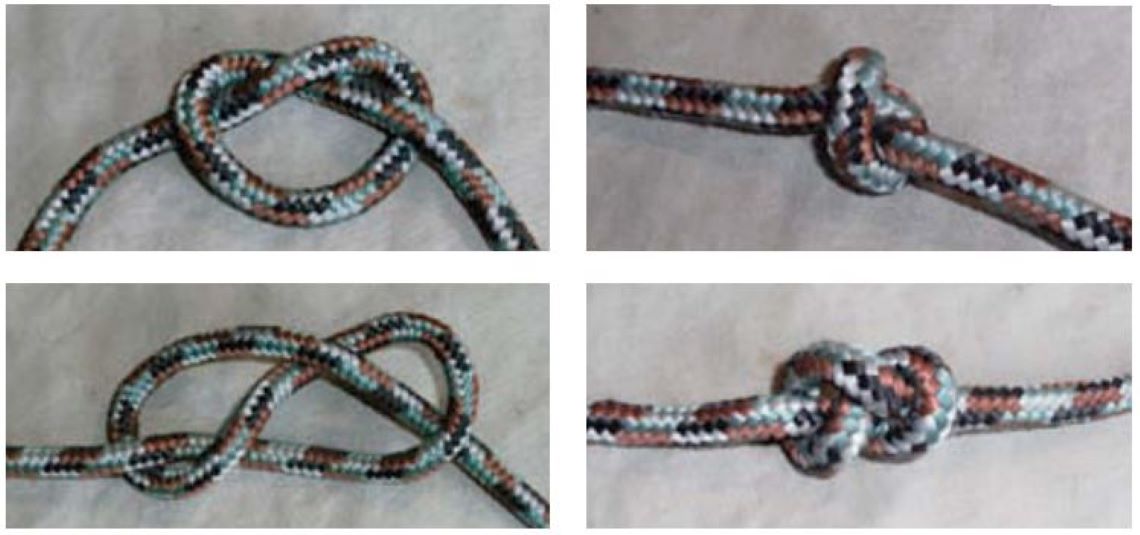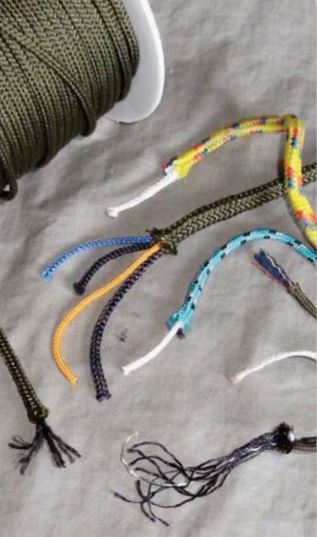FORGET-ME-KNOT
These super-useful knots and lashings are well worth remembering when it comes to fixing kit and improvising on the go, says outdoor expert John Fenna
The most basic and vital skill in extremis is the ability to make and mend kit from whatever you have left, and a good knowledge of strong knots and lashings will help you do this. The following eight knots are the most straightforward and useful.
The Reef Knot

Probably the best-known knot, it’s great for joining two cords of equal thickness and tying the ends of a triangular bandage to make a sling. Easily undone, the reef knot can fail if tied in cords of different sizes or jerked about. To tie: right over left and under, left over right and through (the hole).
The Sheet Bend

This is good for joining two cords of different thicknesses. To tie: form a bight in the end of one cord and bring the other up from below, through the bight, around the back of the neck of the bight, then under itself across the front of the bight. The two loose ends should end up on the same side of the knot.
Clove Hitch

This is the easiest knot to tie the end of a rope to a fixed object and is simple to untie once the tension is removed. To tie: Take the end of the cord over the object you want to attach the cord to, then back and over itself to form a cross. Take the end back around the fixed object and up and under the cross you made.
Round Turn and Two Half Hitches

A superb, strong and easy knot; I use it to sling my hammock and on tow-ropes. To tie: take the end of the rope twice around the object you’re tying the cord to and back over the standing part. Take the end up into the gap between the object and the cord itself, to form a half hitch, and repeat in the same direction as before. The resulting knot should look like a clove hitch.
Bowline

This makes an adjustable loop. To tie: take the ‘tree’ (standing part of the cord), make a ‘rabbit hole’ (loop) in front of the tree; the ‘rabbit’ (working cord end) comes out of the hole (from behind the loop), goes around the back of the ‘tree’ and then jumps back down its ‘hole’.
Figure 8 on the Bight

This gives a secure loop. To tie: form a bight of cord and wrap the end around the neck of the bight twice and back through the loop formed. The knot should look like the number 8.
Slip Knot

A simple self-tightening loop ideal for attaching a cord to soft objects; this knot is easy to untie once the tension is released. To tie: form a loop near the end of the cord and push a bight of the standing part of the cord through the resulting loop; pull the standing part of the cord to tighten. It’s always a good idea to tie a stopper knot in the short end of any knot for security.
Stopper knots

Thumb Knot or Half Hitch – To tie: Wrap the end of the cord around itself and back through the loop formed.
Figure 8 Knot – To tie: As for the Figure 8 on the Bight, but in the plain, not doubled, end of a cord.
Square Lashings

To join two branches, for example, a square lashing is invaluable. To tie: tie the end of the cord to one arm of the crossed items, then go over and under around the cross for a minimum of three turns, then do three frapping turns around the lashing turns without crossing the items to be joined. Finish the lashing with another clove hitch.
Glossary of terms
Cord: Twisted or woven fibres making a line of less than 10mm diam
Rope: Any cordage over 10mm diam
Loop: The part of a cord bent to cross and form an ‘eye’
Bight: A partial loop where the ends do not cross
Standing Part: The part of a cord or rope not being used in the knot
Working End: The end of the cord or rope you are using to tie the knot
Neck: Where a loop or bight is closest
Cordage
The most useful kind of synthetic cord available is 550 paracord. This is made with a woven outer sheath and multiple inner strands of twisted cord. Although thin enough to serves as bootlaces, it’s strong enough to support my chubby 16 stone and more.
If you can’t find genuine 550 paracord, most outdoor shops stock multi-strand cordage. This has the benefit that you can pull the centres out to form fishing line or sewing thread, for example.

